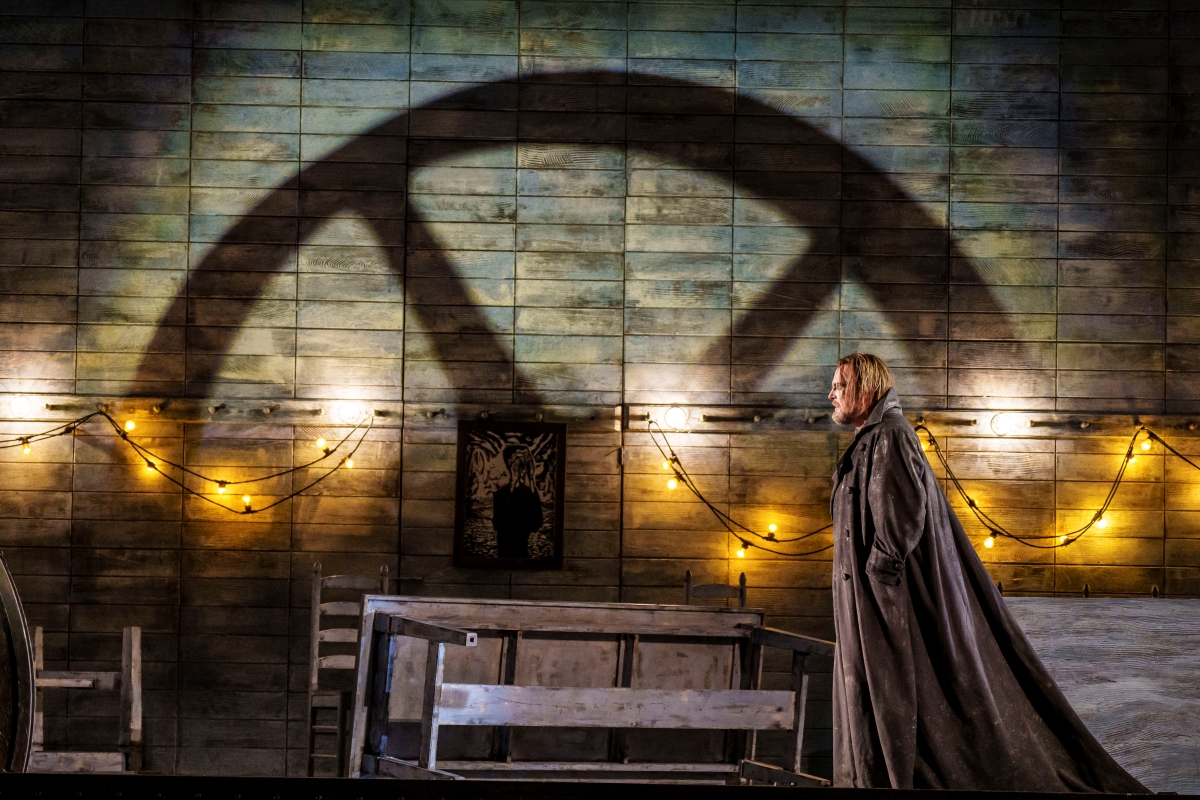
The Lyric Opera has produced some of the finest interpretations of Richard Wagner in the world of opera and the season opener of The Flying Dutchman may be my favorite. I have seen The Ring of the Nibelung twice at Lyric and each production was more fantastic than the last. Wagner dipped into mythology again with the story of a man doomed to sail the turbulent sea forever unless he can find a woman who will pledge love and fealty without remorse. One more thing—he can only touch land every seven years to find this great love.
Director Christopher Alden pulls tragedy, surrealism, and expressionism together in a brilliant staging. Enrique Mazzola begins his third year as music director with a commanding performance from the orchestra, and Michael Black continues as chorus director. Any Wagner opera is a labor of love and a commitment to a marathon of sorts. The Flying Dutchman is spellbinding.

The Dutchman is played with chilling perfection by bass-baritone Tomasz Konieczny. His stage presence as the looming specter of a walking dead man is just fantastic. He and bass Mika Kares as Daland, the ship's captain, command most of the first scene. Kares has a full and smooth bass where even the lowest notes do not get buried in phrasing. He is also a good actor projecting a comical greed once the Dutchman empties his pockets of gold with the promise of more to come if Daland hooks him up with a wife. The bartering of daughters is seen in many myths, fairy tales, and in real life. Cinderella's stepmother tried to barter he daughters as marriage material so that she could live a life of leisure. Daland does not realize that he is under the spell of the Dutchman as much as his daughter Senta (Tamara Wilson) is obsessed with the Dutchman's portrait.
Soprano Tamara Wilson is a brilliant interpreter of Wagner. Wilson is a singer with impeccable pitch and a limber voice that easily hits that high note in "Senta's Ballad." Wilson is a very good actor as a woman under the spell of the Dutchman's portrait. Senta's friend Mary is sung by mezzo-soprano Melody Wilson in her Lyric debut. Mary is a role more acted than sung and Wilson does a good job of acting as being hypnotized by the portrait. She has an eerie stare and the grin of a madwoman that shows how easily the portrait and the legend take possession of minds and souls. Wilson is not afforded the punch needed for Wagner. In her one spotlight song, "Whirr and Whirl as Morning Passes," she is drowned out by the chorus and the orchestra. That should be a problem that the director and chorus master can adjust; it is the one flaw that I found in The Flying Dutchman.

I enjoyed the performance of tenor Ryan Cappozzo as the Steersman who seems to be the only one not under the spell of the Dutchman. He is as fine an actor as he is a singer. He is similar to Renfield in Dracula, driven mad by an entity that only he can see. Cappozzo is a great contrast to the bass and baritone of Konieczny and Kares. To no avail, the Steersman tries to warn Daland not to be blinded by gold and greed.
Tenor Robert Watson makes his Lyric debut as Erik the Huntsman who is waiting for Daland to return so that he can marry Senta. Watson is great as the tortured man losing his love to one who has a considerable fortune. Erik can also see that his beloved is under a spell. He gives an unexpectedly tender performance of the aria reminding Senta of how she was thrilled by his touch. It was the most risqué aria I can recall by Wagner and it turns the tide for the Dutchman who overhears it and can no longer trust Senta to be his salvation.

The Flying Dutchman is enhanced by the excellent lighting design by Anne Militello in another Lyric debut. Militello uses a black-and-white palette with hints of blue for Daland's ship. She drenches the stage in blood red that outlines the doomed crew in the steerage of The Flying Dutchman ship. There is a key scene between the Dutchman and Senta that is done in stark white with Konieczny all in black in profile. I saw it as a visual metaphor of how blinded Senta was even at the thought of him.
The set and costume designer Allen Moyer created a megalith ship on a slant with sharp-angled planks outlining the ghosts in steerage. The Dutchman and his crew are dressed in grey and blue prison garb. The costumes are meant to mirror the clothes of concentration camp prisoners. The expressionistic angling, light, and degenerate art are used to show the ties between Wagner's music, Fascism, and anti-semitism. The portrait is done in the style of Edvard Munch, which ironically as a Norwegian would have been perfect for the so-called master race.
The Flying Dutchman is a magnificent start to the season and I highly recommend that you catch it. The show runs 2 hours and 20 minutes with no intermission at the Civic Opera House, 20 N. Wacker Drive. There are four more opportunities to see this amazing show: September 27 and October 7 with matinees on October 1 and 4. Tickets and more information are available at www.lyric/flyingdutchman. Give yourself an early Dia de los Muertos or a Halloween treat.
For more information on this and other plays, see theatreinchicago.com.
Did you enjoy this post and our coverage of Chicago’s arts scene and sometimes beyond? Please consider supporting Third Coast Review’s arts and culture coverage by making a donation by PayPal. Choose the amount that works best for you, and know how much we appreciate your support!
